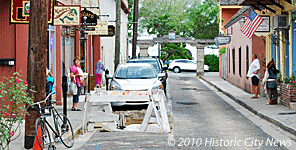 In October 2009, Historic City News reported that Halback Design Group made a presentation to the St. Augustine City Commission to improve access and visibility of Aviles Street; considered the oldest street in the oldest city in the United States.
In October 2009, Historic City News reported that Halback Design Group made a presentation to the St. Augustine City Commission to improve access and visibility of Aviles Street; considered the oldest street in the oldest city in the United States.
Archeological Dig Comes First
The project began in mid April when the city archaeology program initiated a dig within parking spaces along Aviles Street. The purpose of the dig was twofold according to City Archaeologist Carl Halbirt. First, did the parish church of Los Remedios—occupied from 1572 to 1702—extend into the right-of-way? If so, are human burials present in the street that may be disturbed by construction activities? Second, did archaeological evidence exist supporting the claim that Aviles Street was indeed the oldest street in the City? Interpretation of the 1586 Bapiste Boazio Map by various scholars suggests that possibility.
The investigation is mandated by the City’s Archaeological Preservation Ordinance, which requires that all ground-penetrating construction activities be evaluated for their potential to disturbed archaeological remains prior to construction activities. Aviles Street is in an archaeological zone and construction will exceed more than 100 square feet in area: the criteria used to determine if a project trips the ordinance.
Two test areas have been excavated. The first was near the corner of Aviles Street and King Street, across from the Heritage House, which sits atop Los Remedios. That area uncovered a series of earthen street deposits under which was a gas utility line installed in the late 1880s. Aviles Street was paved with brick in the early 1900s. Artifacts recovered from the earthen streets included an assortment of bullet casings, a broach with inlaid garnet stones and a complete boot spur.
The second area was near the intersection of Aviles Street and Artillery Lane which is adjacent to an area identified as containing archaeological deposits associated with the 1572 town. A total of 13 distinct street surfaces have been documented that date from the early 1600s to the present. The earliest surfaces consisted of earthen deposits, with the upper portion consisting of compacted soil. Only toward the end of the First Spanish Period (ca. 1750) was the street paved with oyster shells over which a compacted soil deposit of clay and silt was laid. Numerous artifacts have been recovered from this area which enables the different soil zones to be dated. One of the artifacts is a ceramic figure that was atop the lid to a vessel.
Further archaeological efforts are proposed prior to the beginning of construction.
Planning and Design
In early May the city will replace the worn bricks in the ‘horse hoof path’ south of Artillery Lane with work limited to only mid-week, early morning hours to avoid delaying or impacting businesses on the unique and scenic street.
Also, planning and design are well underway and on target for a July 5 start date with the street closed to vehicles for 60 days. Martha Graham, Director of Public Works for the City of St. Augustine and Project Manager Jeremy Marquis of HDG both stated that although construction will be in progress, the street will remain open to pedestrian access for the duration of the project.
HDG’s plan was approved by the Historic Architectural Review Board prior to the city commission’s approval in October and since that time the city and HDG have had numerous meetings to fine tune the plan. Recent alterations include elimination of the planters and a change in the type of tree canopy for the streetscape.
Marquis stated “The project needs to be ‘surgical’ to be successful. We need to get in, make the improvements, and reopen the street as quickly as possible. Continual pedestrian access to the businesses will be critically important as well.”
The project will include replacing water main, water services and sewer lines, along with placement of the electrical service underground and the installation of new lighting fixtures. In the what is now parking spaces, the sidewalk will be extended to allow on-street café dining areas. Appealing and natural landscaping will then be in place upon completion of the project in early September.
Trinity Episcopal Parish Church
As a sidebar to the project, the City will be making improvements to the Trinity Episcopal Parish Church parking lot at the corner of St. George St. between Artillery Lane and Cadiz.
The city recently entered into a cost share agreement with the church to with a portion of the proceeds to help recoup the cost of the Aviles St. project. The city will install a pay station in the lot in the near future.
The project to improve access and the visibility of Aviles St. was triggered by a necessity to bring it back to life and Marquis is proud that the it will be accomplished adding that the “continued support of the Aviles Street community members and the city commission have been integral to the project. We are working hard to make St. Augustine proud of the oldest street in America.”
For more information on the project contact Martha Graham, P. E., Director of Public Works at 825.1040.
Photo credit: © 2010 Historic City News staff photographer
Discover more from HISTORIC CITY NEWS
Subscribe to get the latest posts sent to your email.

